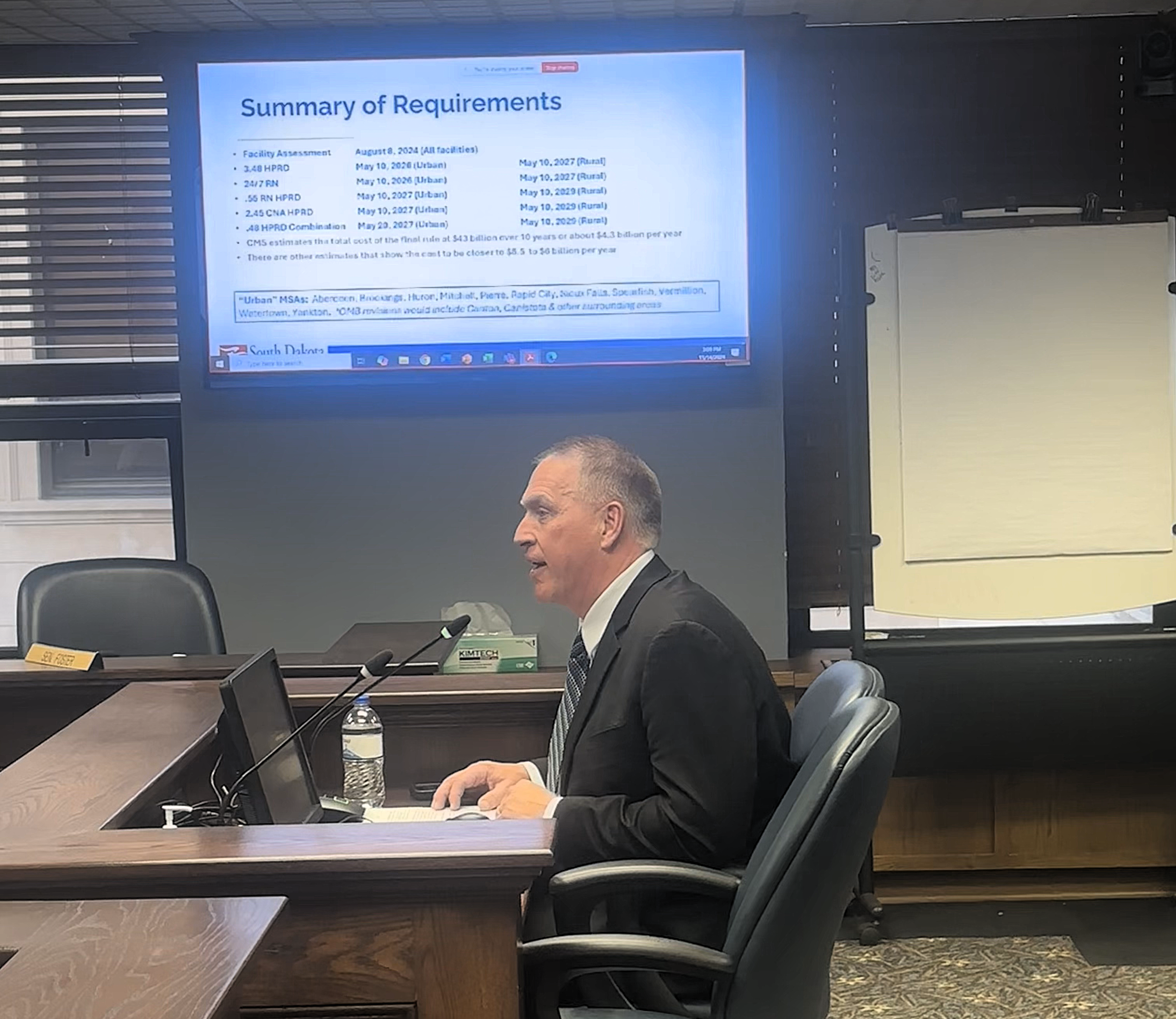South Dakota Association of Healthcare Organizations (SDAHO), Vice President of Post-Acute Care, Justin Hinker spoke to members of the South Dakota Joint Appropriations Committee at the State Capital building on January 14, 2024. Hinker shared updates on the Federal Nursing Home Staffing Mandate, implemented by the Centers for Medicare & Medicaid Services (CMS).
Hinker provided committee members with the mandate requirements, along with their implementation dates.
- May 10, 2026
- (Urban Facilities) will be required to meet the following staffing requirements.
- 3.48 Hours Per Resident Day
- requirement that each facility has a Registered Nurse 24 hours a day/7 days per week.
- (Urban Facilities) will be required to meet the following staffing requirements.
- May 10, 2027
- (Rural Facilities)
- 3.48 Hours Per Resident Day
- requirement that each facility has a Registered Nurse 24 hours a day/7 days per week.
- (Urban Facilities) Requirements have a 3-year phase in:
- 3.48 Hours per resident day
- facilities will be required to staff an RN .55 hours per resident day
- C.N.A. staff at 2.45 hours per day
- a combination of RN/LPN/C.N.A. at .48 hours per resident day.
- (Rural Facilities)
- May 10, 2029
- (Rural Facilities) Requirements have a 5 year phase in:
- 3.48 Hours per resident day
- facilities will be required to staff an RN .55 hours per resident day
- C.N.A. staff at 2.45 hours per day
- a combination of RN/LPN/C.N.A. at .48 hours per resident day.
- (Rural Facilities) Requirements have a 5 year phase in:

Hinker shared with lawmakers concerns over which communities are considered urban and rural. “We would certainly agree that Sioux Falls and Rapid City should be considered urban, but many of our smaller communities are also considered urban under this rule, because they are in a metro service area. SDAHO would argue that these communities should not be included in the urban definition.” Communities listed as urban include Aberdeen, Brookings, Canistota, Canton, Huron, Mitchell, Pierre, Spearfish, Vermillion, Watertown, and Yankton.
CMS estimates the total cost of the mandate to be approximately $4.3 billion per year or $43 billion over 10 years. The full-time equivalents (FTE’s) needed to comply with the mandate is 101,544 and the associated costs is estimated to be $5.75 billion according to Clifton Larson, an accounting company that specializes in work for non-profit organizations and a respected leader in the healthcare industry, Hinker told committee members. “This mandate comes at a time when there is a shrinking workforce in the nursing home industry. The total number of staff working in nursing facilities has decreased sharply and has not recovered from pre-pandemic.”
Today data shows that less than 5% of South Dakota nursing facilities are meeting the .55 hours per resident day RN minimum requirement. Only 6% meet the C.N.A 2.45 hours per resident day requirement and only 5% meet the total 3.48 hours per resident day requirement. “There is a high percentage of our facilities that are using some contract staffing in their facility. If facilities have to hire contract, temporary or traveler staff to meet the mandate, their costs will be significantly higher.”
Hinker shared with lawmakers, there have been two lawsuits to challenge the CMS mandate. The first filed on May 23 by LeadingAge and the American Health Care Association. The lawsuit argues that CMS does not have statutory authority because Congress has already set out staffing standards and CMS should not enact a one size fits all rule or mandate RN Coverage. That lawsuit is currently in a 5-step briefing schedule, with the next briefing scheduled for November 15 and the final briefing in January. The second lawsuit was filed on October 8, 2024 by 17 LeadingAge state affiliates representing 21 states and Attorney’s General in 20 states including South Dakota. The lawsuit is asking for injunctive relief for facilities because they need to start ramping up now to comply with the mandate to be implemented in 2026 and beyond. Hinker stated, “We are opposing this mandate with every tool we have, including joining with South Dakota’s Attorney General on the lawsuit asking for injunctive relief. This mandate is going to cost facilities in South Dakota nearly $20 million dollars, and this will continue to put a strain on the budget of our state.”
Hinker concluded his remarks with a few key points for lawmakers:
- With a new administration in January, there could be a decision to suspend the implementation of the staffing mandate
- The two lawsuits that were filed stating CMS doesn’t have statutory authority and looking for injunctive relief.
- There are several bills federally that could overturn the mandate and there is a Supreme Court decision on the Chevron doctrine that says that government agencies are overextending their authority with mandates.
“We must continue to invest in the healthcare continuum for seniors in South Dakota utilizing all settings to include Assisted Living, home health, hospice, and palliative care. It is going to be vital to prioritize our home and community-based services to take the pressure off hospitals and nursing homes.” The CMS Staffing Mandate has brought renewed attention to the nursing home industry, but the challenges it faces will persist, regardless of any changes to the mandate.
To listen to the full committee hearing visit SD.NET archived section or click here.




